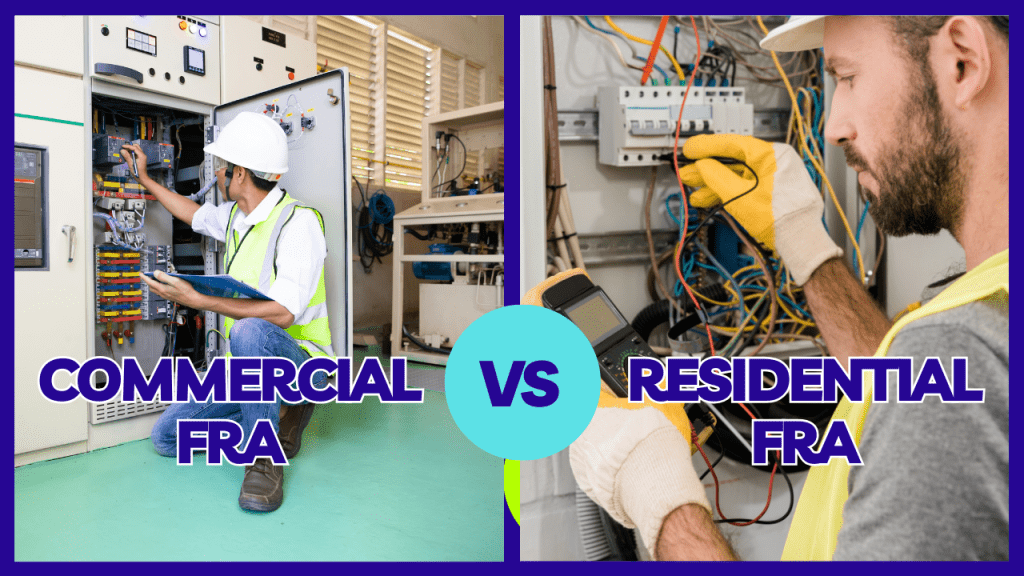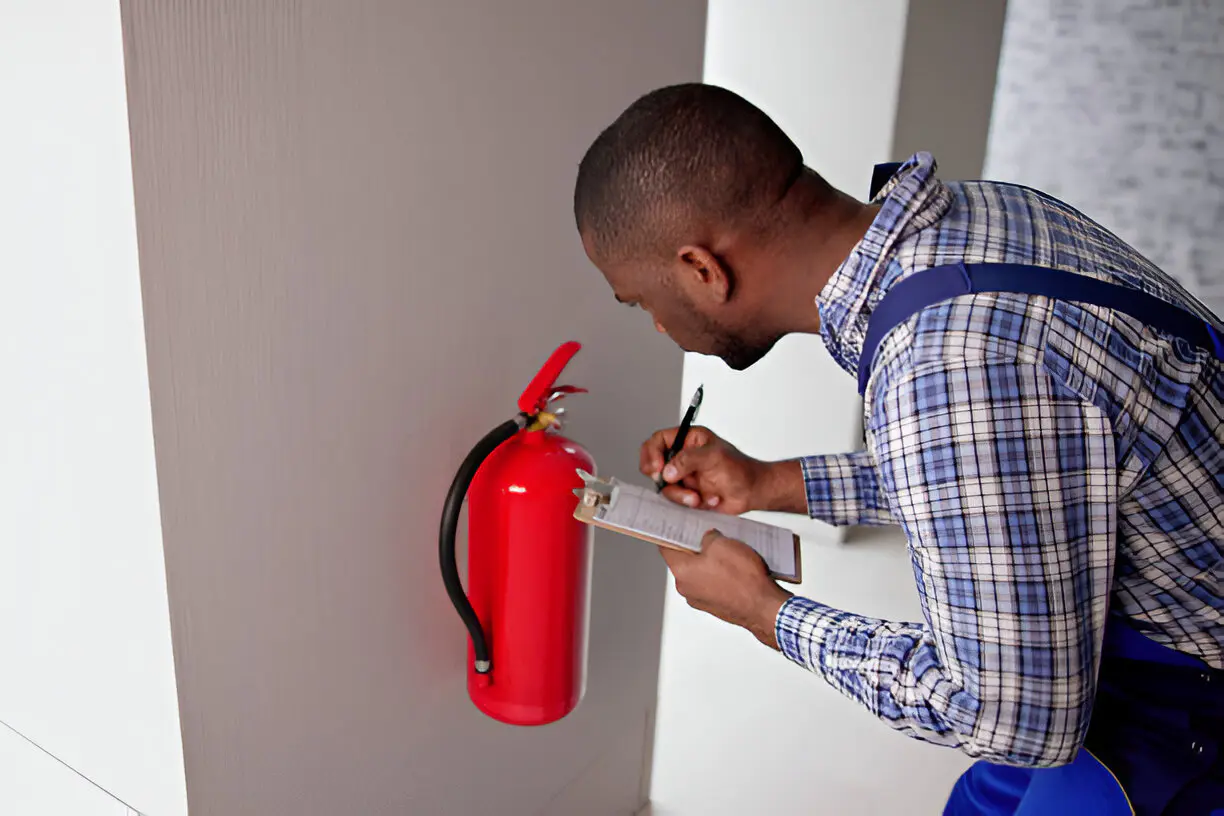In fire safety, conducting thorough Fire Risk Assessments (FRAs) is crucial, particularly given the diverse requirements across various property types. From residential buildings, where the focus is on escape routes and smoke alarm functionality, to industrial sites requiring more complex strategies involving chemical hazards and large-scale emergency protocols, each environment calls for a tailored approach. This nuanced landscape prompts a critical question: how do different FRAs ensure comprehensive coverage and compliance with fire safety standards, and what potential gaps might go unnoticed, Let’s understand the Types of Fire Risk Assessments.
Residential vs. Commercial FRAs
In the realm of fire risk assessments (FRAs), distinguishing between residential and commercial environments is crucial. Each sector comes with its unique set of challenges and regulatory requirements that must be meticulously addressed to ensure optimal safety and compliance.

Residential fire hazards often involve everyday activities and equipment, such as cooking appliances and heating systems. Fire safety regulations in these settings focus on ensuring that escape routes are accessible and that smoke alarms are properly installed and maintained.
Tenant fire responsibilities typically include regular testing of smoke alarms and ensuring that no flammable materials are stored in unsafe manners. Property owner obligations extend to providing fire-resistant building materials and ensuring the installation of adequate fire suppression systems.
In contrast, commercial fire protocols are generally more complex, reflecting the higher risks associated with larger numbers of occupants and the presence of commercial machinery or chemicals.
Businesses must adhere to stringent fire safety regulations, which include the installation of sophisticated fire alarm systems, regular fire drills, and the maintenance of clear evacuation routes.
Property owners in commercial settings are responsible for conducting professional FRAs periodically and implementing recommendations promptly, thus ensuring both property and occupant safety.
FRA for High-Risk Buildings
While fire risk assessments are integral to all buildings, they become especially critical in high-risk structures such as hospitals, schools, and industrial facilities.
These buildings not only house a large number of occupants but also contain more complex infrastructures, which pose unique high-rise challenges and necessitate robust evacuation strategies.
Fire prevention in these settings must adhere strictly to regulatory compliance to mitigate risks effectively. This includes implementing advanced fire detection systems, ensuring easy accessibility to fire exits, and maintaining all fire safety equipment in excellent operational condition.
Furthermore, the architecture of such buildings often requires specialized fire protection strategies due to the complexity of their design and the functions they serve.
Occupant training is another critical component of fire risk assessments in high-risk buildings. Regular drills and education sessions are imperative to ensure that everyone knows how to act swiftly and safely in the event of a fire.
This training should cover not only basic fire safety principles but also tailored guidance specific to the building’s layout and potential hazards.
Specialist Fire Risk Assessments
Beyond general fire safety practices in high-risk buildings, some scenarios demand Specialist Fire Risk Assessments. This type of assessment is essential in environments where the standard measures of fire safety are insufficient due to unique risks or complex operational processes. Specialist assessments delve deeply into specific areas to develop tailored fire safety audits, risk mitigation strategies, and emergency evacuation plans that conform to stringent compliance regulations.

Specialist Fire Risk Assessments focus on enhancing the detailed understanding of potential fire hazards and the effectiveness of existing fire safety measures. These assessments typically include a comprehensive review of fire safety infrastructure, detailed scrutiny of operational procedures, and rigorous staff training programs. The goal is to ensure a high level of preparedness and the capacity for rapid, coordinated response in the event of a fire.
Here is a breakdown of the key components:
| Component | Description | Importance |
|---|---|---|
| Fire Safety Audits | Examination of current fire safety measures. | Ensures regulatory compliance and identifies gaps. |
| Risk Mitigation Strategies | Plans were developed to reduce risk levels. | Minimizes potential impact of fire hazards. |
| Emergency Evacuation Plans | Detailed routes and procedures for evacuation. | Facilitates safe and efficient response during emergencies. |
| Staff Training Programs | Education on fire safety and emergency response. | Enhances readiness and effectiveness of staff actions. |
Each element is crucial for a comprehensive Specialist Fire Risk Assessment, safeguarding lives and property against fire-related incidents.
Fire Risk Assessments for Industrial Sites
Fire Risk Assessments for industrial sites are critically important due to the complex and hazardous nature of operations typically conducted within these environments. The primary goal is to identify potential fire hazards, implement industrial safety measures, and ensure the efficacy of fire suppression systems.
Detailed assessments involve a meticulous review of all operational areas, focusing on fire hazard identification and the integrity of existing fire prevention and control systems.
Industrial sites vary in their specific risks, from chemical processing plants to manufacturing facilities, each with unique challenges requiring bespoke fire safety strategies. The complexity of machinery, the nature of materials processed, and the layout of the site all contribute to the fire risk profile.
Therefore, comprehensive fire risk assessments are essential in these settings to protect both human lives and valuable industrial assets.
Key aspects include:
- Fire Hazard Identification: Systematic identification and evaluation of all potential fire sources and fuel materials present on the site.
- Emergency Evacuation Procedures: Development and refinement of evacuation protocols to ensure rapid and safe exit routes for all personnel.
- Regulatory Compliance Audits: Regular audits to verify adherence to national and international fire safety standards, which helps in maintaining operational licenses and avoiding legal penalties.
These assessments must be thorough, and conducted by experts familiar with the specific industrial sector, ensuring all findings are actionable and compliance is achieved.
Comprehensive Fire Safety Plans for Large-scale Properties
In addressing fire safety on a broader scale, comprehensive fire safety plans for large-scale properties are indispensable. These plans must align with stringent fire safety regulations to ensure the well-being of occupants and the protection of assets.
Key components include detailed emergency evacuation procedures tailored to the unique layout and size of the property, enabling swift and safe exits in crises.
Incorporating advanced fire prevention technologies is also crucial. These systems, ranging from smoke detectors to high-end sprinkler systems, play a pivotal role in early detection and control of fire, providing crucial response time.
Furthermore, staff training programs ensure that all employees are equipped with the knowledge and skills necessary to act decisively and effectively during emergencies. These programs should cover the use of fire extinguishers, execution of evacuation plans, and first-response measures.
Additionally, risk assessment methodologies form the backbone of these plans. They involve a thorough analysis of potential fire hazards, evaluating the effectiveness of existing fire control measures, and identifying areas of improvement.
Conclusion
In conclusion, the diversity of Fire Risk Assessments is essential for addressing the distinct safety requirements of various environments. Residential, commercial, and high-risk building assessments each play critical roles in minimizing fire hazards through specific strategies tailored to their respective contexts. By implementing comprehensive safety plans and specialized evaluations, these assessments significantly enhance the effectiveness of fire safety measures, ultimately safeguarding lives and property across different settings.









